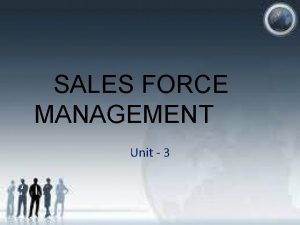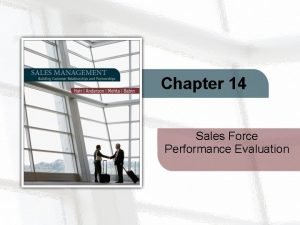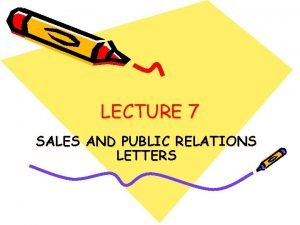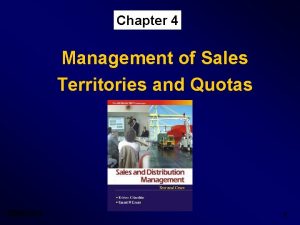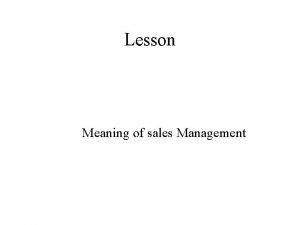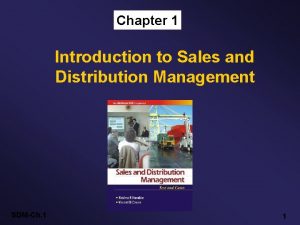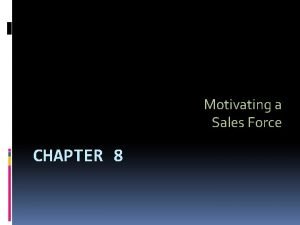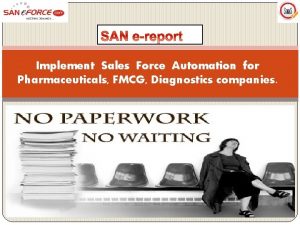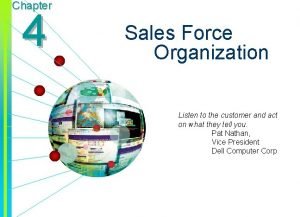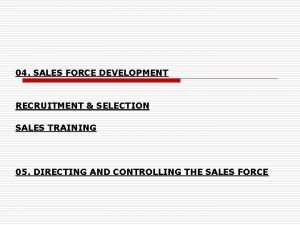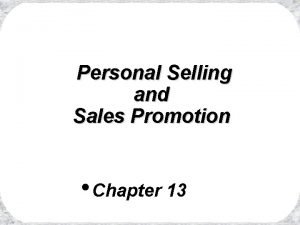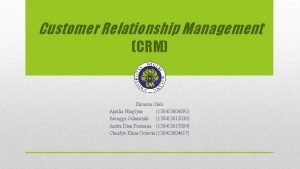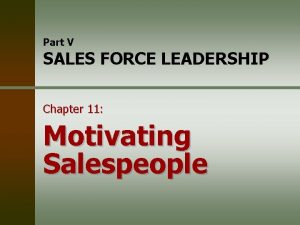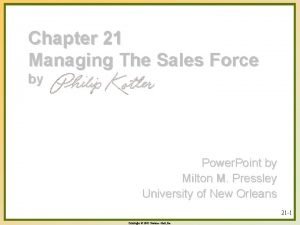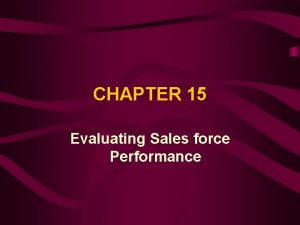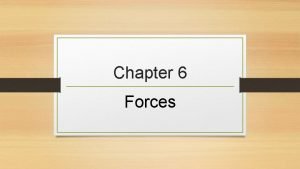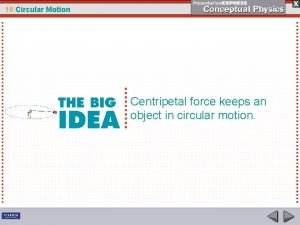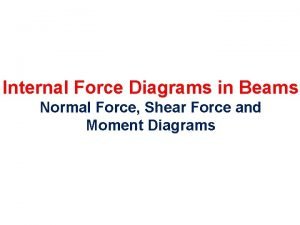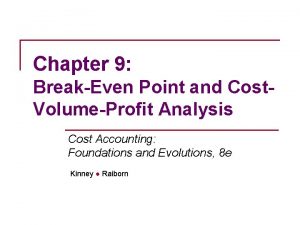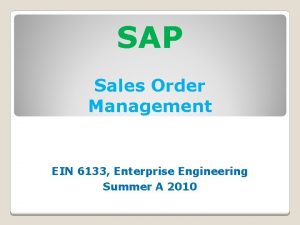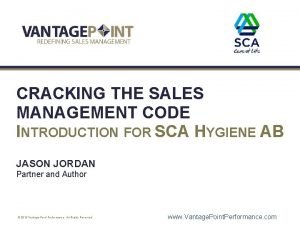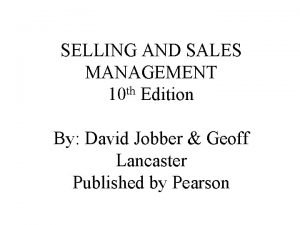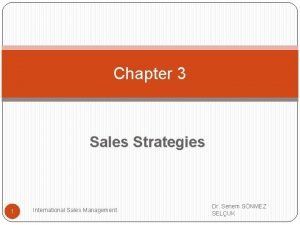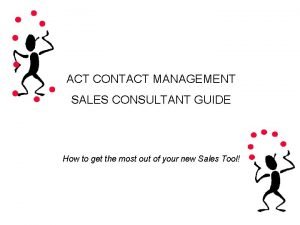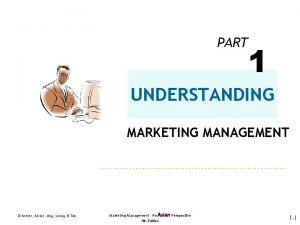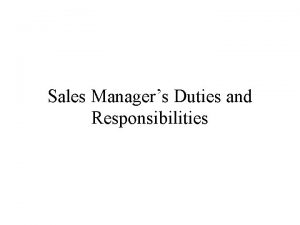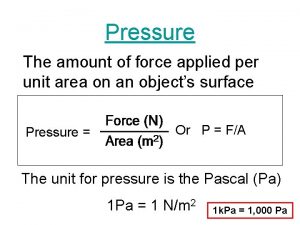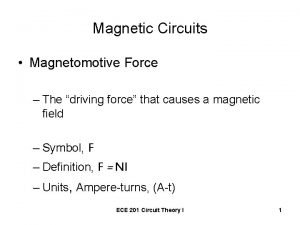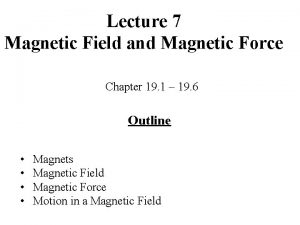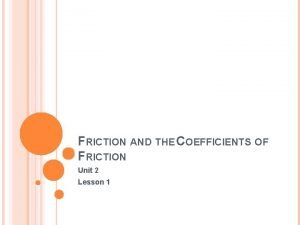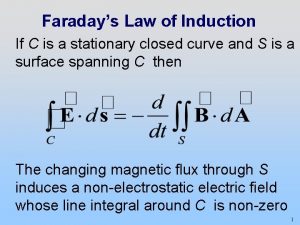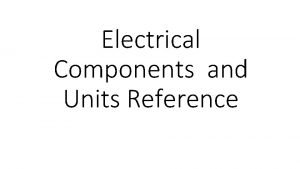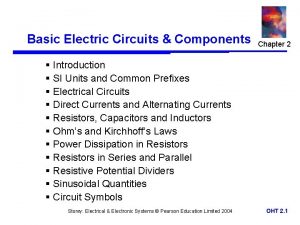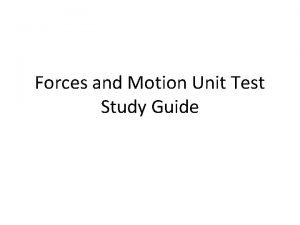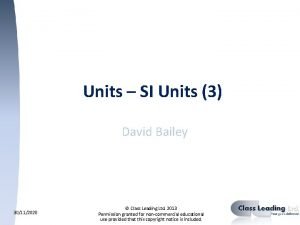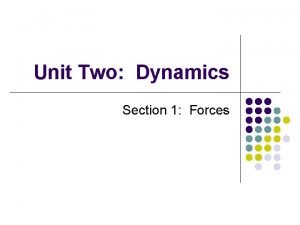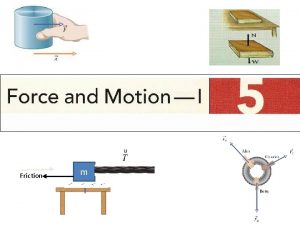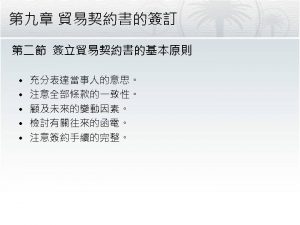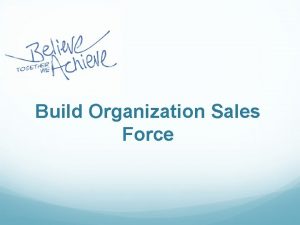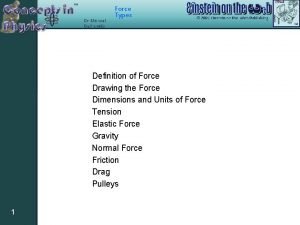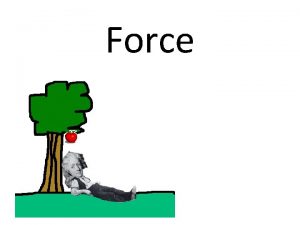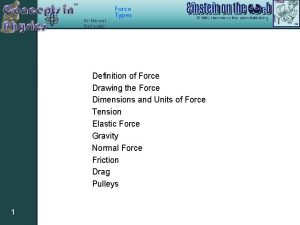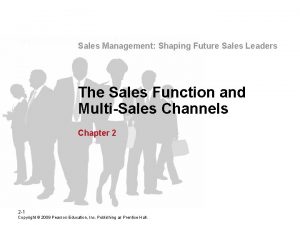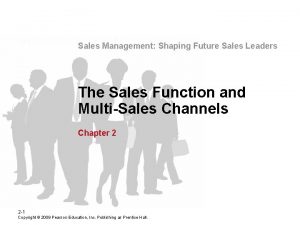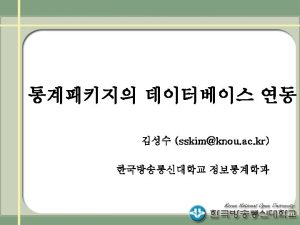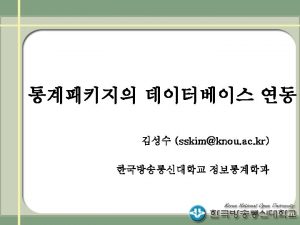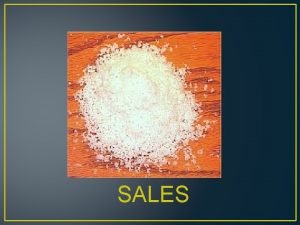SALES FORCE MANAGEMENT Unit 3 Meaning Definition Meaning
























































































- Slides: 88

SALES FORCE MANAGEMENT Unit - 3


Meaning & Definition Meaning: Recruitment is the process where the prospective candidate s are found and encouraged to apply. The aim of recruitment is to attract potential salesmen to fill up the vacancies. Definition: “Recruitment is the active search for the best available candidates for a sale position. ” - Victor P. Buell

Characteristics of Recruitment • Recruitment Induction is the process of finding good salesmen in which they are encouraged to apply. • It is a continuous process. The search for salesmen goes on all the time. • The various sources of recruitment are determined in it. • Recruitment is done to fulfill both present and future requirements.

Process of Recruitment of Salesmen Recruitment of salesmen involves the following processes: I. Determination of Nature of salesmen II. Determination of Number of salesmen III. Determination of sources of recruitment of salesmen.

Determination of Nature of Salesmen • Sales personnel planning involves two important activitiesi. Determining the type of sales personnel needed. ii. The number of sales personnel required to be recruited.

(i) Determining the type of sales personnel needed. • To measure the activities involved in identifying the type of sales personnel the following are needed: i. Sales Job Analysis ii. Personal Analysis

Sales Job Analysis means job analysis of sales function. This is concerned with the determination of nature of duties and responsibilities to be performed. In job analysis the following two activities are involved: • Job description • Job specification


Job Description • Job description includes basic job-related data that is useful to advertise a specific job and attract a pool of talent. • It includes information such as job title, job location, reporting to and of employees, job summary, nature and objectives of a job, tasks and duties to be performed, working conditions, machines, tools and equipments to be used by a prospective worker and hazards involved in it.

Purpose of Job Description • The main purpose of job description is to collect jobrelated data in order to advertise for a particular job. It helps in attracting, targeting, recruiting and selecting the right candidate for the right job. • It is done to determine what needs to be delivered in a particular job. It clarifies what employees are supposed to do if selected for that particular job opening. • It gives recruiting staff a clear view what kind of candidate is required by a particular department or division to perform a specific task or job. • It also clarifies who will report to whom.

Job Specification Also known as employee specifications, a job • specification is a written statement of educational qualifications, specific qualities, level of experience, physical, emotional, technical and communication skills required to perform a job, responsibilities involved in a job and other unusual sensory demands. It also includes general health, mental health, intelligence, aptitude, memory, judgment, leadership skills, emotional ability, adaptability, flexibility, values and ethics, manners and creativity, etc.

Purpose of Job Specification • Described on the basis of job description, job specification helps candidates analyze whether are eligible to apply for a particular job vacancy or not. • It helps recruiting team of an organization understand what level of qualifications, qualities and set of characteristics should be present in a candidate to make him or her eligible for the job opening. • Job detailed information about any job Specification including job gives responsibilities, desired technical and physical skills, conversational ability and much more. • It helps in selecting the most appropriate candidate for a particular job.

Determination of Number of Salesmen Before selection is undertaken, the sales manager should assess the need for sales force in quantitative terms. Number of salesmen are estimated on the basis of i. Future sales ii. Sales per salesmen iii. Possibilities of future development iv. Present no. of salesmen The following formula is used : N = S/P (1+T) N = No. Of salesmen S = Forecasted sales P = Productivity of salesmen T = Rate of sales turnover

Determination of Source of Recruitment of Salesmen Sources of recruitment may be broadly be divided into : a. Internal sources b. External sources

Internal Sources • From company’s own staff • Company executives • Promotion of employees • Former employee’s re-employment

External Sources • Educational institutions • Employment agencies • Salesmen of non-competing companies • Competing firms • Employees of customers • Application on gate • Advertisements • Wholesalers, retailers and customers • Professional bodies


Meaning of Selection The process of interviewing and evaluating candidates for a specific job and selecting an individual for employment based on certain criteria. Employee selection can range from a very simple process to a very complicated process depending on the firm hiring and the position.

Importance of Sound Selection • Basic of sales • Establishment of better relations • Better relations with customers • Easy and quick training • Low cost of control • Limited turnover • Availability of good executives • Growth of organisation and increase in reputation. • Peaceful atmosphere

Who Selects the Salesman • By The Owner Of The Enterprise • By Sales Manager • By Personnel Department • By Selection Board • By External Agencies

Principles to be Followed in Selection of Salesman • Aptitude of salesmanship • Adequate education and knowledge of language • Application form • Checking references • Personal interviews • Psychological test • Medical examination • Final interview and appointment

Selection Test • Mental Ability Test (capacity of comprehension and reasoning) • Aptitude Test (potential ability) • Achievement Test (gain from education and training) • Personality Test (assess an individual motivation, stress, interpersonal relation and self-image) • Interests Test (likes and dislikes)

Conditions for Effective Use of Tests • The test should be properly prepared. • The test should be job related. • Capable and experiences person should handle the test. • If possible more than one tests should be used. • The dangers and limitations of different tests should be kept in mind. • The test should be reviewed periodically. • The reliability and validity of any test should be accepted before it is used as a selection tool.

Methods of Interview • Patterned interview • Indirect or non-directive interview • Stress interview • Group interview

Sales Force Training

Meaning & Definition Meaning: Sales training is very important and covers generally three broad areas namely – knowledge, skill and attitude – all three a must for development of an effective salesman. Definition: According to E. B. Fillippo, “ Training is the act of increasing the knowledge and skills of an employee for doing a particular job. ”

Objectives of Sales Training • Identifying Customer Needs • Qualifying Opportunities • Demonstrating Value • Overcoming Objections

Importance of Sales Training • Lower turnover of sales people • Better customer relations • High sales volume • Reduces control and supervision • Reduces selling cost • Provides expert knowledge

Types of Sales Training • Initial training : new recruits are given an orientation training so as to know about the company and its products. He may be allowed to work for sometime in the firm itself to gain sufficient information about the products. After that he is sent to work in his field. • Job training : In this method, a new salesman is placed under an experienced or senior salesman who trains him. Initially he trains the sales techniques, later, takes the trainee along with him on his rounds and gives him chances to observe the dealings with the customers. • Refresher training : Short-term course aimed at recall and reinforcement of previously acquired knowledge and skills. It is a form of updating knowledge.

Contents of Good Training Scheme • Objectives • Basic principles of salesmanship • Information about the firm • Information about the product • Training methods • Information about the competitors • Information about market conditions • Information about customers • Matters pertaining day to day work • Evaluation

Planning of Sales Training Programme • A planned training programme should function with the following ideas or principles, often referred as ACMEE. A – Aim of Training C – Content of Training M – Method of Training E – Execution of the Training E – Evaluation

Aim of Training • Job specifications • Time management • Sales related marketing policies • Product data • Sales Techniques • Markets and competition • Company information

Content of Training • • Content for new sales trainees is broader. It includes: • Company knowledge • Product knowledge • Customer knowledge • Competitor knowledge • Selling skills / sales techniques Examples of specific content for experienced salespersons are: • New product knowledge • Introduce change in sales organisation • Negotiating skills Content depends on the aims of training programme Who, what, where and when Manuals and printed materials Training aids Candid camera, You. Tube Assignments

Method of Training • • • Selection of suitable methods for a training programme depends upon the topic and audience. Lecture Personal Conference (Curbstone Conference) Role Playing Case discussion Impromptu discussion Gaming On-the-job Programmed Learning Group or individual

Execution of the Training • Usually sales trainer or sales training manager is responsible for entire process of sales training. • Execution/implementation includes preparing timetable, arranging internal / external trainers, making travel arrangements of participants, arranging conference hall and teaching aids, and so on • A good practice to make a final check one / two days prior to start of training programme • Obtain feedback from the sales trainees at the end of the programme

Evaluation • Session Review • Written tests • Send observers • Candid camera

It is done to improve training design and implementation, and to find if expenditure was worthwhile. Framework for sales training evaluation Outcomes to measure What to measure How to measure When to measure • Reactions / Perceptions of participants • Training objective • Was training worthwhile? • Questionnaires • interviews • After the training • Learning – knowledge, skills, attitudes learnt • Knowledge, skills, attitudes • Tests • Interviews • After training • Before & after – training • Behavioural change • Trainees’ change of behaviour • Self-assessment by • After training, over a trainees period of one year • Observation by supervisors / customers • Results – Performance; Benefits more than cost? • Sales, Profits • Company data • Customer satisfaction • Management judgement • Market survey • After training, Quarterly, Yearly

Training Methods The various methods used to train the salesmen may be grouped as follows: • Group training method • Individual training method

Group Training Method • • • Lecture Method Group Discussion Sales Conference Role Playing Method Case Study Round Table Method Sales Demonstration Simulation or Game Method Visual Training

Lecture Method • lectures are delivered by senior supervisors and leading experts to a group of trainee consisting of 15 to 20 trainees who are sitting in a room.

Case Study • Under this method, an actual or hypothetical case of sales is discussed by the trainees inthe presence and guidance of senior supervisor. There are open and frank discussions amongst the members(trainees).

Role Playing Method • Under this method, training is provided to the trainee by presenting a sales drama before the trainees

Simulation or Game Method • This method also known as Simulation. • Uses highly structured contrived situations, based on reality , in which players assume decision-making roles through successive rounds of play

Individual Training Method In is a method where the principle of ‘self-help’ is adopted. The salesman is asked to see, observe and learn for himself. Various methods used are: • On the Job Training • Personal Discussion • Sales Manuals • Job Rotation Training • Correspondence Courses • Internship Training

On the Job Training • It is a practical method of training in which the trainee gets actual experience by working along with some senior supervisor on the job.

Personal Discussion • In the Personal conference, the trainer and trainee jointly analyze problems. It is an unstructured and informal method.

Correspondence Courses • The special study courses are supplied to the trainees through post by a recognized institution regularly at the residence of the trainees.

Internship Training • This method of training refers to a joint programme of training in which the technical institution and business houses co-operate

Sales Force Motivation













Sales Compensation

Meaning of Remuneration • Remuneration is the total compensation that an employee receives in exchange for the services he/she performed for the employer. • Typically, this consists of monetary rewards, also referred to as wage or salary and includes a number of complementary benefits. • In other words, it is reward for employment in the form of pay, salary, or wage, including allowances, benefits (such as company car, medical plan, pension plan), bonuses, cash incentives, and monetary value of the noncash incentives.

Need of Remuneration A good scheme of remuneration can help to fulfill the following major functions: • Attracting sufficient and desirable sales people. • Rewarding sales employees for productivity. • Retaining desirable sales people. • Correcting sales costs with sales results. • Controlling sales activities.

Essentials of a Good Remuneration • Simplicity • Direct Incentive • Minimum Income • Helpful to increase efficiency • Flexibility • Lower Administrative • Proportionate reward • Fair and equitable Cost • Periodic Increment • Promptness • Stability • Talent oriented

Factors Affecting Remuneration of Salesmen • Nature of Product or Service • Nature of Competition • • • New Product or New Market • Reputation and Financial Position of the Enterprise Condition of the Market Experience and Efficiency • Competitive Position • Remuneration of the of Salesman Competitive Institution Amount of Sale • Amenities Advertising Sales Promotion • Economic condition of the country

Compensation Elements A sales compensation plan has many as four basic elements. 1. A fixed element, either a salary or a drawing account, to provide some stability of income. 2. A variable element (for example, a commission , bonus, or profit sharing arrangement) to serve as an incentive. 3. An element covering the fringe or “plus factor”, such as paid vacations, sickness & accident benefits, life insurance, pensions. 4. An element providing for reimbursement of expenses or payment of expenses allowances.

Methods of Remuneration • • • • Time Rate Method Piece Rate Method Fixed Salary or Straight Line Method Straight Commission Method Salary and Commission Method Drawing Account and Commission Method Salary Bonus and Commission Method Bonus Method Quota Method Promotion Method Fringe Benefits Method Pooled Commission Method Sales Contest and Prize Method

Time Rate Method: • Under time rate system, remuneration is directly linked with the time spent or devoted by an employee on the job. The employees are paid a fixed predecided amount hourly, daily, weekly or monthly irrespective of their output. It is a very simple method of remuneration. It leads to minimum wastage of resources and lesser chances of accidents. Time Rate method leads to quality output and this method is very beneficial to new employees as they can learn their work without any reduction in their salaries. This method encourages employees unity as employees of a particular group/cadre get equal salaries. • There are some drawbacks of Time Rate Method, such as, it leads to tight supervision, indefinite employee cost, lesser efficiency of employees as there is no distinction made between efficient and inefficient employees, and lesser morale of employees. • Time rate system is more suitable where the work is non-repetitive in nature and emphasis is more on quality output rather than quantity output.

Piece Rate Method • It is a method of compensation in which remuneration is paid on the basis of units or pieces produced by an employee. In this system emphasis is more on quantity output rather than quality output. Under this system the determination of employee cost per unit is not difficult because salaries differ with output. There is less supervision required under this method and hence the per unit cost of production is low. This system improves the morale of the employees as the salaries are directly related with their work efforts. There is greater work-efficiency in this method. • There are some drawbacks of this method, such as, it is not easily computable, leads to deterioration in work quality, wastage of resources, lesser unity of employees, higher cost of production and insecurity among the employees. • Piece rate system is more suitable where the nature of work is repetitive and quantity is emphasized more than quality.

Fixed Salary or Straight Line Method It is simplest compensation plan. Salesperson receive fixed sums as regular intervals(usually each week or month sometimes every 2 weeks), representing total payments for their services. Such plans are more common among industrial- goods companies than among consumer- goods companies. Such plans are engaged in trade selling. These jobs, in which selling amounts to mere order taking, abound in the wholesale & manufacturing fields, where consumer necessities are distributed directly to retailers. It is also used for paying driver- salesperson selling liquor & beverages, milk & bread, similarly distributed products.

Straight Commission Method The theory supports the individual sales personnel should be paid according to productivity. As sales volume rises to different levels, the commission rates differ for different products, categories of customers, or during selling seasons. This method is common in the clothing, textiles & shoe industries & in drug * hardware wholesaling. Firms selling intangibles, such as insurance & investment securities, manufacturers of furniture, office equipment & business machines also are frequent users of straight- commission plans.

Salary and Commission Method Most sales compensation plans are combinations of salary & commission plans. By a judicious blending of the two basic plans, management seeks both control & motivation. Actual results depend upon management’s skills in designing & administering the plan.

Drawing Account and Commission Method • Under this, the firm maintains salespeople’s individual accounts from which the money is advanced to the salespeople against future commissions and the commissions due are credited to this account periodically. The overdrawn amount is adjusted in future.

Salary Bonus and Commission Method • In this, the straight salary is paid for certain specific duties performed by the salesmen. In case the salesmen puts extra efforts or sells beyond a pre-determined limit, he is paid commission and bonus. The quantum of commission bonus depend upon – Volume of sales – Profits of the company The form of commission bonus may be in the form of cash or prizes or services to members of the family.

Bonus Method • A bonus is an amount paid for accomplishing a specific sales task, it is paid for reaching sales quota, performing promotional activities, obtaining new accounts, following up leads, setting up displays, or carrying out other assigned works. • It is like an additional financial reward to the sales person for achieving results beyond a predetermined minimum.

Quota Method • In this method, a fixed salary is paid but the calculation of commission is not paid on total sales effected by salesperson. • A minimum quota is fixed for each salesman and no commission is paid until he crosses his quota figure. • In other words, he has to qualify himself for the benefit of commission by selling over the quota fixed for him over a time period.

Fringe Benefits Method • Fringe benefits do not bear direct relationships to job performance. • They lack the motivational force, but take care of the safety and security needs. • They are provided by federal & state law. • For example, payment for social security premiums, unemployment compensation, worker’s compensation, pension plan, holidays, vacations, hospitalization, insurance, car parking, company providing housing etc.

Pooled Commission Method • Under this method, salesmen working in a certain area are regarded as a team. The total commission earned on the sales of the group as a whole is then divided amongst the salesmen. • This division may be equal , or may be partly on the individual sales and the remaining is evenly distributed. • By making each person partly responsible for the earnings of each member of the group, an atmosphere is created which is expected to prove stimulating.

Sales Contest and Prize Method • Sometimes companies use sales contests and offer prizes to boost the competitive spirits of the salesmen. As a result to win sales contest, salesmen make special efforts to increase sales volume. Special quotas are fixed and salesmen who are able to reach those targets are properly rewarded. These rewards may be in the form of cash or other benefit. s

Sales Force Evaluations






QUERRIES ?
 Product sales structure
Product sales structure Sales force deployment
Sales force deployment Force management definition
Force management definition Evaluating sales performance
Evaluating sales performance Difference between sales letter and sales promotion letter
Difference between sales letter and sales promotion letter Sales force composite
Sales force composite Management of sales territories and quotas
Management of sales territories and quotas Tahapan sales cycle
Tahapan sales cycle Sales management meaning
Sales management meaning Importance of sales and distribution management
Importance of sales and distribution management Relationship adalah
Relationship adalah Sfa mobile
Sfa mobile Motivating sales force
Motivating sales force Sanapp sfa
Sanapp sfa Functional sales organization
Functional sales organization Sales force expenses
Sales force expenses Salesforce recruitment and selection process
Salesforce recruitment and selection process Sales promotion methods
Sales promotion methods Sales force automation
Sales force automation Evaluating sales performance
Evaluating sales performance Contoh aplikasi sales force automation
Contoh aplikasi sales force automation Methods of sales force motivation
Methods of sales force motivation Sales force effectiveness ppt
Sales force effectiveness ppt Sales force mobility
Sales force mobility Sfa sales force automation
Sfa sales force automation Evaluating sales force performance
Evaluating sales force performance Unit 6 review questions
Unit 6 review questions Contact vs non contact forces
Contact vs non contact forces Which arrow below represents the direction of acceleration
Which arrow below represents the direction of acceleration Long range force
Long range force If you whirl a tin can on the end of a string
If you whirl a tin can on the end of a string How does mechanical advantage work
How does mechanical advantage work Unbalanced force
Unbalanced force Centripetal force in geography
Centripetal force in geography Is air resistance a contact or noncontact force
Is air resistance a contact or noncontact force Is electric force a conservative force
Is electric force a conservative force Centripetal force and gravitational force
Centripetal force and gravitational force Normal force and gravitational force
Normal force and gravitational force Shear force diagram
Shear force diagram Break even point dollars formula
Break even point dollars formula Introduction of personal selling
Introduction of personal selling Sap order management
Sap order management Wessex sales management simulation
Wessex sales management simulation Cracking the sales management code pdf download
Cracking the sales management code pdf download Personal selling process in sales management
Personal selling process in sales management Introduction to sales management
Introduction to sales management Selling and sales management
Selling and sales management In the twenty-first century, sales leaders are
In the twenty-first century, sales leaders are International sales management
International sales management Act sales management
Act sales management Sales activity management system
Sales activity management system Advertising management and sales promotion
Advertising management and sales promotion Territory management best practices
Territory management best practices Sfa performance management
Sfa performance management Sales performance management framework
Sales performance management framework Sales promotion in marketing management
Sales promotion in marketing management Sales management assignment
Sales management assignment Area sales manager roles and responsibilities pdf
Area sales manager roles and responsibilities pdf Objective of sales management
Objective of sales management A water glass sitting on a table weighs 4n
A water glass sitting on a table weighs 4n Moments of force
Moments of force Moment physics
Moment physics Magnetomotive force symbol
Magnetomotive force symbol Magnetic flux units
Magnetic flux units Air force unit structure
Air force unit structure Coefficient of friction units
Coefficient of friction units Electromotive force unit
Electromotive force unit Electromotive force unit
Electromotive force unit Kirchhoff
Kirchhoff Unit 3 force motion energy answer key
Unit 3 force motion energy answer key Electromagnetic force meaning
Electromagnetic force meaning Forces and motion unit test
Forces and motion unit test Unit of electrical force
Unit of electrical force Observation of electromagnet
Observation of electromagnet Units of magnetic field
Units of magnetic field Buoyant force
Buoyant force Is
Is Si unit of force
Si unit of force Lingual bar major connector
Lingual bar major connector Pressure is defined as force per unit area.
Pressure is defined as force per unit area. Si unit of force is
Si unit of force is Pyramid levels of management
Pyramid levels of management Top management middle management first line management
Top management middle management first line management Top level management
Top level management Maximize sales meaning
Maximize sales meaning Sales readiness definition
Sales readiness definition Nature of salesmanship
Nature of salesmanship Sales letter
Sales letter Sales acceleration definition
Sales acceleration definition


